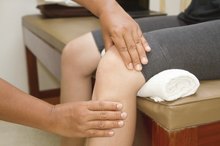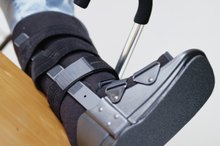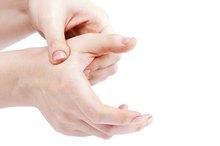Ulnar Osteotomy Rehabilitation Protocols
An ulnar osteotomy, a medical procedure that shortens, lengthens or realigns the ulna bone in your forearm, can be undertaken because of a fracture, arthritis, or general wear-and-tear on the cartilage and tissues in your wrist or elbow joints. Rehabilitation protocols after an ulnar osteotomy aim to help promote healing and improve mobility. Follow rehabilitation guidelines and exercises only under the supervision of you doctor.
Ulnar Osteotomy
Your ulna bone, one of the two bones in your forearm, runs alongside the ulnar nerve from your elbow into your wrist. The larger of the two bones, the radius, runs from your elbow to your wrist on the thumb side of your forearm. When damage appears in the wrist joint cartilage that holds the ulna and radius bones together, movements can result in pain. An ulnar shortening osteotomy removes part of the ulna bone and inserts a plate to hold the bone together. This surgical procedure can promote increased movement and less pain across the ulnar side of your wrist. You may also require an ulnar osteotomy after an injury that dislocates the radius bone and fractures the ulnar bone in your elbow joint. An ulnar osteotomy helps realign the bones in your elbow to promote healing.
General Rehabilitation Protocols
Physical Therapy Exercises for Basal Joint Arthroplasty
Learn More
General rehabilitation protocols after an ulnar osteotomy aim to restore full function in the affected joint. Individual protocols vary, but your rehabilitation might involve range-of-motion and strengthening exercises. Post-surgery recovery techniques usually include methods to control pain, such as hot or cold treatments, as well as methods to prevent injury, such as using a cast or splint for several weeks. You may begin with gentle range-of-motion exercises and progress to resistance activities, such as using weights, which can promote range of motion, strength and exercise endurance with repeated repetitions. In addition, you will likely complete exercises under the direction of a physical therapist or receive occupational therapy to instruct you in safe ways to perform daily activities. In the beginning phases of your recovery, you might perform passive and active-assisted exercises. Passive exercises require no self-participation, while you complete active-assisted exercises with some help. Later in your rehabilitation protocol, you can perform active exercises entirely on your own.
Rehabilitation Protocol for Wrist Ulnar Osteotomy
After surgery, you'll usually wear a plaster dressing for protection. During this stage of recovery, hand surgeon Harry Belcher recommends keeping your hand elevated and performing supination and pronation exercises, which rotate your forearm away from and toward your body, to promote range of motion. Supination exercises rotate your forearm so that your palm faces up. Pronation exercises rotate your forearm so your palm faces down. Protocol after seven to 14 days can include wearing a splint and performing light activities, along with supination and pronation exercises. However, avoid movements that twist your arms, such as using a steering wheel. Six weeks after an ulnar shortening osteotomy you might perform pronation and supination exercises using weights to increase strength in the pronator, supinator and bicep muscles in your forearm. It might take 12 to 16 weeks to fully return to your normal activities.
Rehabilitation Protocol for Elbow Ulnar Osteotomy
How Long Is Rehab After a Bicep Surgery?
Learn More
Three to five days after an elbow ulnar osteotomy, rehabilitation goals generally focus on controlling pain and swelling, protecting your elbow with a splint or cast and maintaining mobility. Physical therapist Dr. Cuong Pho recommends gentle range-of-motion exercises that include your shoulder, wrist and fingers as well as passive flexion, or bending, and extension elbow exercises. You may also complete passive pronation and supination exercises. After seven days to three weeks, you might perform active-assisted elbow flexions and extensions as well as active-assisted pronation and supination exercises. After four to six weeks, your doctor or therapist may suggest active exercises and gentle stretching. The final stages of your rehabilitation protocol may include flexion and extension exercises using weights or resistance bands to help strengthen your elbow extensor and flexor muscles.
Related Articles
References
- Pncl.co.uk; Ulnar Osteotomy; Harry Belcher; 2010
- "Strategies in Trauma and Limb Reconstruction"; Open Reduction and Corrective Ulnar Osteotomy for Missed Radial Head Dislocations in Children; D. Eygendaal, et al.; April 2007
- Kaiser Permanente; Radial Head Fracture Repair and Rehabilitation; Cuong Pho, et al.
- MDGuidelines; Osteotomy; 2010
Resources
Writer Bio
Jan Millehan has published articles relating to health, fitness and disease on various websites. Her publishing history includes health-related articles on blogs and online directories, as well as an essay published in the Bridgewater College journal, "Philomathean." Millehan received a Bachelor of Science in elementary education from Bridgewater College.









